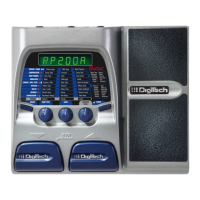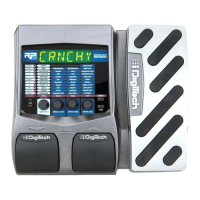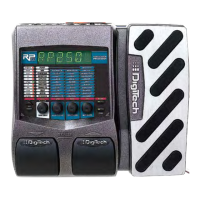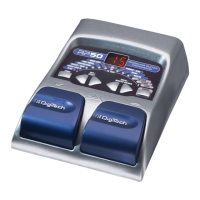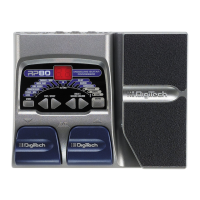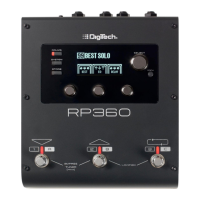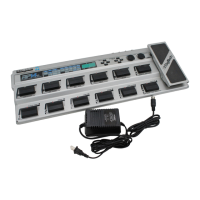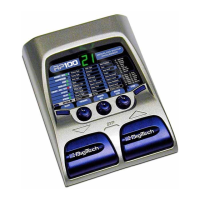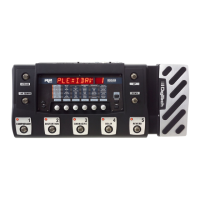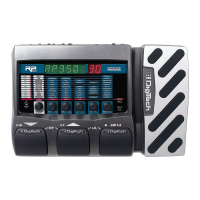Do you have a question about the DigiTech RP200 and is the answer not in the manual?
Warns about electrical shock, opening the unit, and exposure to water or moisture.
Details precautions for power sources, grounding, cord protection, and servicing.
Explains EMC compliance requirements and usage guidelines.
Lists product specifications and compliance with safety and EMC directives.
Outlines the warranty terms, conditions, limitations, and consumer responsibilities.
Welcomes the user and encourages familiarization with the product and guide.
Lists the items that should be included with the RP200 package.
Identifies and labels the main controls and features on the RP200's front panel.
Describes footswitches, parameter knobs, Select button, Rhythm feature, and the Matrix display.
Explains the display information, the Store button for saving, and the Expression Pedal's function.
Details the function and connection type for each jack on the rear panel.
Guides users on connecting the RP200 for mono operation with a guitar and amplifier.
Details how to connect the RP200 for stereo sound using a Y-cord.
Provides steps for safely applying power and setting initial volume levels.
Explains the concept of presets, distinguishing between user and factory presets.
Details the functions and operations of Performance and Bypass modes.
Guides users on how to use the RP200's built-in tuner and its features.
Provides a step-by-step guide for editing and creating custom sound presets.
Explains how the Matrix interface is used to navigate and select effects and parameters for editing.
Guides users on how to save their custom sound creations and name them.
Describes how to select the destination for saving the modified preset using footswitches.
Illustrates the signal flow of effects and introduces the section defining each effect.
Explains the Pickup/Wah simulation and Compressor effects, including their parameters.
Describes the Amp Modeling feature and its available amp types, gain, and level parameters.
Details the Equalization (EQ) controls for adjusting bass, mid, and treble frequencies.
Explains Cabinet Modeling options and the function of the Noise Gate.
Details the parameters for the Noise Gate, including Gate Type and Threshold.
Describes the Chorus and Flange effects, including their Amount and Level parameters.
Details the Phaser, Tremolo, and Panner effects and their respective parameters.
Explains the Vibrato, Rotary Speaker, and YaYa™ effects and their parameters.
Describes the AutoYa™, Synth Talk™, and Envelope Filter effects and their parameters.
Details the Detune and Pitch Shift effects, including their pitch difference and interval parameters.
Explains the Whammy™ and Delay effects, covering pitch bends, delay types, time, and feedback.
Details the Reverb effect, including types, decay time, and level adjustments.
Describes the Rhythm Trainer for timing practice and Jam-A-Long for playing along with external audio.
Guides users on assigning control parameters to the Expression Pedal for real-time manipulation.
Lists various parameters that can be controlled by the Expression Pedal, such as Wah, Gain, and Volume.
Details the procedure to reset the RP200 to its original factory settings, erasing user data.
Guides users on recalibrating the Expression Pedal, especially after a factory reset.
Provides a detailed list of the RP200's technical specifications, including connectivity and dimensions.
A comprehensive list of all available factory and user presets for the RP200.
Warns about electrical shock, opening the unit, and exposure to water or moisture.
Details precautions for power sources, grounding, cord protection, and servicing.
Explains EMC compliance requirements and usage guidelines.
Lists product specifications and compliance with safety and EMC directives.
Outlines the warranty terms, conditions, limitations, and consumer responsibilities.
Welcomes the user and encourages familiarization with the product and guide.
Lists the items that should be included with the RP200 package.
Identifies and labels the main controls and features on the RP200's front panel.
Describes footswitches, parameter knobs, Select button, Rhythm feature, and the Matrix display.
Explains the display information, the Store button for saving, and the Expression Pedal's function.
Details the function and connection type for each jack on the rear panel.
Guides users on connecting the RP200 for mono operation with a guitar and amplifier.
Details how to connect the RP200 for stereo sound using a Y-cord.
Provides steps for safely applying power and setting initial volume levels.
Explains the concept of presets, distinguishing between user and factory presets.
Details the functions and operations of Performance and Bypass modes.
Guides users on how to use the RP200's built-in tuner and its features.
Provides a step-by-step guide for editing and creating custom sound presets.
Explains how the Matrix interface is used to navigate and select effects and parameters for editing.
Guides users on how to save their custom sound creations and name them.
Describes how to select the destination for saving the modified preset using footswitches.
Illustrates the signal flow of effects and introduces the section defining each effect.
Explains the Pickup/Wah simulation and Compressor effects, including their parameters.
Describes the Amp Modeling feature and its available amp types, gain, and level parameters.
Details the Equalization (EQ) controls for adjusting bass, mid, and treble frequencies.
Explains Cabinet Modeling options and the function of the Noise Gate.
Details the parameters for the Noise Gate, including Gate Type and Threshold.
Describes the Chorus and Flange effects, including their Amount and Level parameters.
Details the Phaser, Tremolo, and Panner effects and their respective parameters.
Explains the Vibrato, Rotary Speaker, and YaYa™ effects and their parameters.
Describes the AutoYa™, Synth Talk™, and Envelope Filter effects and their parameters.
Details the Detune and Pitch Shift effects, including their pitch difference and interval parameters.
Explains the Whammy™ and Delay effects, covering pitch bends, delay types, time, and feedback.
Details the Reverb effect, including types, decay time, and level adjustments.
Describes the Rhythm Trainer for timing practice and Jam-A-Long for playing along with external audio.
Guides users on assigning control parameters to the Expression Pedal for real-time manipulation.
Lists various parameters that can be controlled by the Expression Pedal, such as Wah, Gain, and Volume.
Details the procedure to reset the RP200 to its original factory settings, erasing user data.
Guides users on recalibrating the Expression Pedal, especially after a factory reset.
Provides a detailed list of the RP200's technical specifications, including connectivity and dimensions.
A comprehensive list of all available factory and user presets for the RP200.
| Brand | DigiTech |
|---|---|
| Model | RP200 |
| Category | Music Pedal |
| Language | English |
